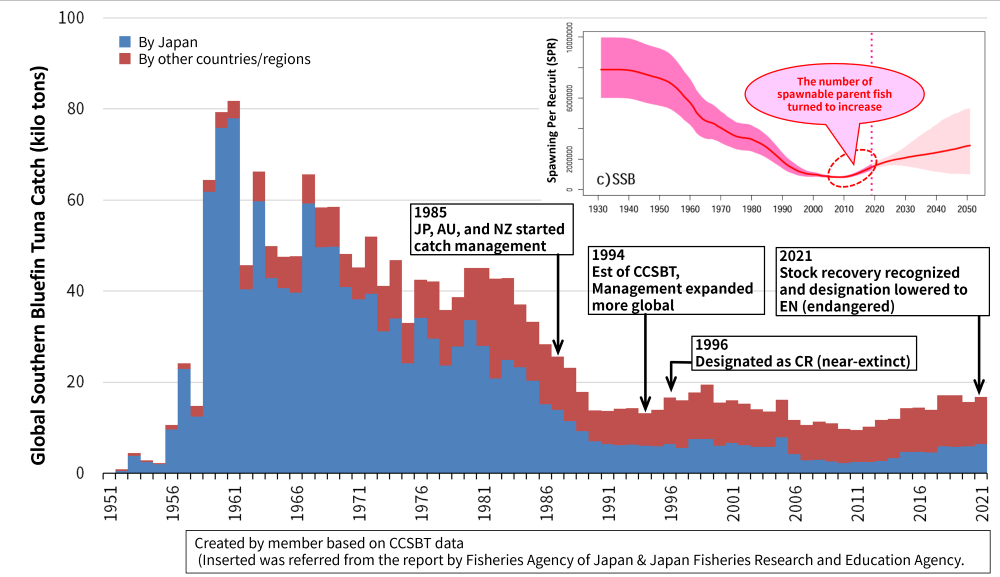Recovery of Resource by Catch Management
Resources usually run out after use.
However, since organisms can reproduce by giving birth, biological resources can be used sustainably if they are used in a moderate manner.
Here, we will use southern bluefin tuna as an example to explain efforts to limit catches and the current state of resource recovery.
Southern Bluefin Tuna
Southern bluefin tuna are distributed in the southern hemisphere in the cold waters around 50 to 30 degrees south latitude.Southern bluefin tuna, like bluefin tuna and Pacific bluefin tuna, is considered a luxury item in the market because of its high toro (fatty tuna) content. To meet the demand, many southern bluefin tuna were caught from the sea.As a result, in the late 1950s, the global annual catch was more than 80,000 tons, but the catch declined rapidly thereafter, and by the mid-1980s it was internationally recognized as being
Commission for the Conservation of Southern Bluefin Tuna (CCSBT)
In 1985,
The CCSBT aims
CCSBT is explained again in "![]() For Sustainability → RFMOs"
For Sustainability → RFMOs"
Recovery of southern bluefin tuna stocks
Since the beginning of fishing restrictions based on catch quotas by the CCSBT, the downward trend in southern bluefin tuna abundance has been halted.On the other hand, the abundance of southern bluefin tuna has not yet reached the level of the pre-1980s (Figure).However,

Figure. Trends in catch and spawning parent index of southern bluefin tuna and stock recovery

|
I am supplised that the international management by CCSBT has stoped the declining trend of natural resource of southern bluefin tuna and some recoverly of fisherly productions. |
Tuna Quiz (6)
Why the lisk of extinction of Southern Bluefin Tuna in 2021 assess lower than previous in 2011?
Because resources have returned to the levels of the 1950s.
Incorrect!It seems that it will take a while longer for the resource levels to reach the levels of the 1950s.
Because the number of adult fish that can lay eggs is increasing.
Correct!Increase of egg-laying parent fish will let to increase fingerlings.
Increase of fingerlings expext to let to increase of overall southern bluefin tuna.
Because peaple stopped catching them.
Incorrect!We continue to catch southern bluefin tuna with adhering to the catch quota rules.
Reference
https://www.ccsbt.org/
https://kokushi.fra.go.jp/index-2.html
(in Japanese)
![]() Home
© 2022-2023 マグロの学校/School-of-Tuna All rights reserved.
Home
© 2022-2023 マグロの学校/School-of-Tuna All rights reserved.